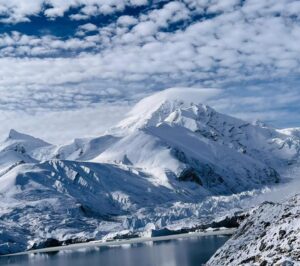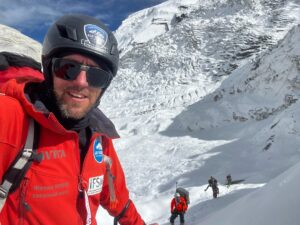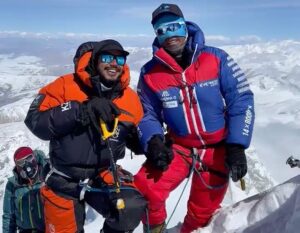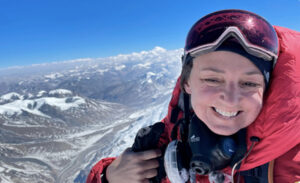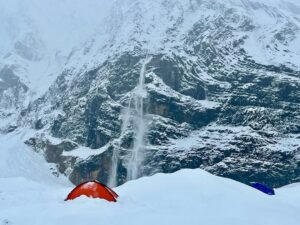Guinness World Records — better known for awarding those with the world’s largest collection of rubber ducks or who can spin a basketball on a toothbrush the longest — has deprived Reinhold Messner, 79, of being the first to officially climb all the 8,000m peaks. Messner never reached the true summit of Annapurna, it states.
This is an old quarrel, but the South Tyrolean still gets as angry as the first time he heard this argument. Eberhard Jurgalski of 8000ers.com — and recent head consultant for Guinness World Records (GWR) on mountaineering issues — has published an updated list of those who reached the true summits of all 14 8,000m peaks.
Guinness is constantly updating its list of largely insignificant — but profitable — “firsts,” but its presence in mountaineering and other adventure activities is particularly contentious. It issues tons of certificates with which commercial climbers proudly adorn their Instagram accounts. Meanwhile, it strips one of the greatest mountaineers ever of a keystone accomplishment.
Background
The controversy started as 8000ers.com updated its historical statistics on summits. This followed a series of detailed reports about the summit areas of Manaslu, Dhaulagiri, and Annapurna. These peaks all feature long summit ridges where the highest point can be confusing, depending on visibility and snow cover.
After checking photographic evidence and strictly deciding that “the summit is the highest point and no other,” the 8000ers.com team took away the accomplishments of not only Messner but virtually all the mountain heroes of a generation. Jerzy Kukuczka, Erhard Loretan, as well as women record holders Edurne Pasaban and Gerlinde Kaltenbrunner, were re-categorized with only 11 to 13 summits to their name rather than the full 14.
Many 20th century 8,000m climbers — those still alive to have an opinion — have despised Jurgalski’s interpretation or simply ignored it. Denis Urubko, who had three of his own summits cast into doubt — including the spectacular new route up Cho Oyu’s south side — contested so vigorously with Jurgalski’s team that he finally managed to get a “no evidence” designation.
Messner’s contempt
Meanwhile, Messner and others received a humiliating “proved no summit” black mark. (Check table below). The South Tyrolean spared no words of contempt for this revision of life’s achievements.
To define the designations: Claimed summits are the summits that the climber says he/she has done. Proved no summits refers to the summits he/she actually didn’t reach, according to 8000ers.com research. For example, Messner’s Annapurna. No evidence are those cases where the climber says he/she summited and 8000ers.com cannot prove them right or wrong, because there is not enough evidence one way or the other. This is the designation that Urubko received for his Cho Oyu south side.

Latest update of the 14×8,000m table, noting ‘claimed summits,’ ‘proved summits,’ those with ‘no evidence,’ and those ‘proved no summits.’ The full-sized table is here.
Back in July, ExplorersWeb discussed this in a feature story. We acknowledged the huge amount of research that 8000ers.com has put in and accepted the photographic and other evidence they used to interpret who reached a true summit and who didn’t.
At the same time, many historical “firsts” took place in a different era, before unimpeachable geographic evidence. Intention matters, and many climbers in those earlier decades had reached what they truly believed was the highest point of their mountain.
The new top dogs
Currently, 8000ers.com (and Guinness) state that the first to summit the 14×8,000’ers is American Ed Viesturs. He did his quest between 1989 and 2005 without supplementary oxygen. Number two is Veikka Gustafsson (who often teamed up with Viesturs). Nirmal Purja, who used oxygen on all the peaks, is number three. In an Instagram post, Viesturs himself broke a long silence and credits Messner with being first.
Since the new list knocked Edurne Pasaban and Gerlinde Kaltenbrunner down to just 12 summits, the female category stood vacant until a complete unknown, Dong Hong Juan of China, summited Shishapangma this past spring. Kristin Harila and other female commercial climbers followed in quick succession.
While accurate from a true summit perspective, the sight of heavily supported clients getting recognition over Messner and Pasaban has sort of killed the adventurous allure of the challenge itself.

Messner (or Kammerlander) during their 1985 ascent of Annapurna. Photo: Facebook
“Not the summit but the path is the goal. My alpinism knows no records,” Messner posted on Facebook yesterday. He included a photo of his and Hans Kammerlander’s ascent of Annapurna back in 1985.
Indeed, theirs was an epic climb via a new route in alpine style up the Northwest Face, in bad weather. Their feat is a world away from the current 8,000m climbs. No one disputes that, including Jurgalski.
But the summit is a different story. “The mountain changes, like everything in nature…all it takes is for the snow frame to collapse and the peak lowers by five meters,” Messner told La Repubblica. “The ridge leading to the summit is three kilometers long, Jurgalski simply confused the east summit with the main one,” he added. In typical Messner fashion, he then proceeded to define Jurgalski as “someone in search of attention without having the slightest competence.”
Jurgalski’s take
Jurgalski has not yet publicly replied to Messner’s statements, but on several occasions, he has defended the accuracy of his research. He bases his reports strictly on geography and frankly admits that he does not consider the style of a climb. He explained his position at length in an article posted in July 2022.
“We found out that Messner obviously stopped at the ridge junction…only five meters in altitude, but 65 meters in distance [from Annapurna’s true summit].”
Since then, Jurgalski has faced a storm of negative comments. Mostly, the critics invalidate Jurgalski’s assessment because he is not a high-altitude climber himself. Yet Jurgalski and his team have done immense research for over 20 years that no one else was willing to undertake. They are still at it, even after The Himalayan Database stated that they would stop interviewing participants of climbs of 8,000m normal routes.
Does it make sense anymore?
In the end, the question is whether keeping account of summits on the 8,000’ers still makes any sense. Perhaps it’s time to stop counting, as it happened on the popular peaks of the European Alps and the Seven Summits.
Guinness World Records, in particular, was never a reference for mountaineering achievements, until the thriving tourism industry in Nepal found it a powerful marketing tool. Now a wave of GWR certificates swamps the social media of Nepali guides, who summit one 8,000m peak after another for eight months a year to earn a living. Meanwhile, their clients, many with big egos, piggyback on this certificate madness. No complaints from the outfitters: It’s great for business.

A member of the Guinness World Records with Elite Exped owner Nirmal Purja and his multiple certificates. Photo: GWR/Facebook
In fact, outfitters may point out to their clients that climbing several peaks at once may allow them to obtain some obscure record.
Finally, Guinness also makes a profit for its accreditation services. Everyone wins.

Shehroze Kashif of Pakistan is on his way to breaking 14×8,000m records for age and nationality. Photo: Shehroze Kashif/Instagram
Kristin Harila admitted to Norway’s media that she was done with mountaineering, and the story we published about it sparked a healthy debate among commenters. Strictly speaking, Harila never said she was going to become a professional climber. She entered the 8,000m scene to prove something — that all 14 peaks on the 8,000m list could be completed in less than six months. She made her point. The underlying question is whether she also proved how senseless some records are.
New requirements: on foot, please!
Things have changed on the 8,000’ers to the point that Guinness and Jurgalski’s team have deemed it necessary to set new official requirements for successful summits. One, a climber has to reach the highest point and prove it. Two, they need to make the entire ascent on foot and not use helicopters part of the way — to avoid the dangerous Khumbu Icefall, for example.
Clearly, when Messner and Habeler climbed Everest without oxygen for the first time in 1978, that possibility was not even in their wildest dreams. Now it has become a shameful open secret in the industrialized 8,000’ers.


